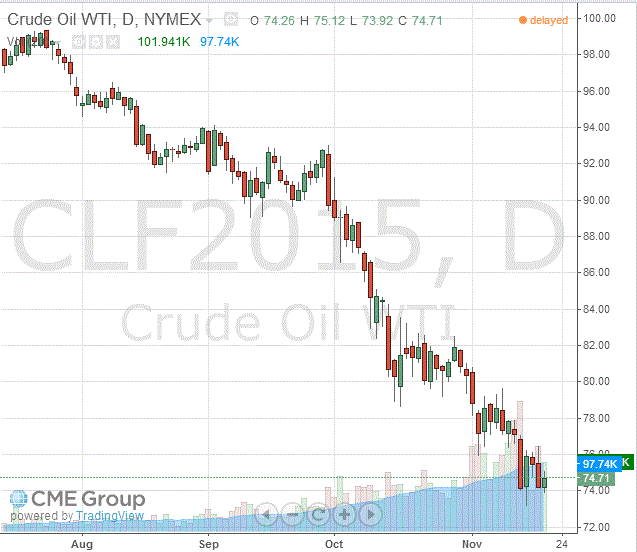- Oil: A review of the market situation
Market news
Oil: A review of the market situation
The price of oil rose moderately, closer to $ 79 (Brent) and $ 75 (WTI) amid speculation that OPEC may take measures to stabilize prices, which have fallen by almost a third in five months.
It is worth emphasizing that the oil ministers of Saudi Arabia and Kuwait are opposed to the reduction of production, while Libya, Venezuela and Ecuador are insisting on the adoption of measures to prevent further price declines. OPEC oil ministers scheduled a meeting in Vienna on November 27, during which intend to consider whether to adjust the current volume of production at 30 million. B / d at the beginning of 2015.
"Agreed to reduce production will be difficult. I think that the market does not believe in it, and even if OPEC said it was ready to cut production, I think many would react skeptical, "- said a senior strategist at CMC Markets in Sydney, Michael McCarty.
Meanwhile, today the head of the Energy Information Agency of the Ministry of Energy of the United States allowed the fall of Adam Seminsky world oil prices to $ 50 per barrel. He also said that according to forecasts of most analysts, WTI crude oil falls to $ 62 per barrel by mid-2015. With oil prices at $ 60 per barrel increase in the production of shale oil in the US may stop Seminsky added. However, to accurately predict the cost of oil Seminsky not. Predict the price of oil prevented the geopolitical problems and conflicts in Libya, Iraq and other countries.
The course of trade also affected the data on oil reserves in the United States. The Department of Energy reported that commercial oil reserves in the vaults of the United States during the week of 8-14 November rose by 2.6 million barrels to 381.1 million barrels, while the average forecast assumed their fall by 1 million barrels. Stocks rose to a maximum of 4 July. Oil reserves in Cushing terminal rose to 23.2 million barrels, the highest level since May 9. Gasoline inventories rose by 1 million barrels to 204.6 million barrels. Analysts expected gasoline supplies to increase by 600,000 barrels. Distillate stocks fell by 2.1 million barrels to 114.8 million barrels, the lowest level since May 9, while analysts had expected a decrease of 1.4 million barrels.
Utilization rate of refining capacity rose to 91.2%. Earlier, analysts expected an increase in the index by 0.3 percentage points.
We also recall that yesterday after markets closed the American Petroleum Institute reported that US crude stocks rose 3.7 million barrels for the week ended November 14th. The report also showed that gasoline inventories rose by 519,000 barrels, while distillate inventories decreased by 3.3 million. Barrels.
Cost of January futures for US light crude oil WTI (Light Sweet Crude Oil) rose to 74.70 dollars per barrel on the New York Mercantile Exchange.
January futures price for North Sea petroleum mix of Brent rose $ 0.36 to $ 78.76 a barrel on the London Stock Exchange ICE Futures Europe.
